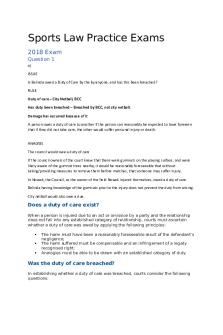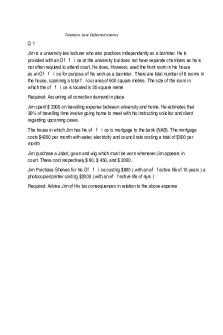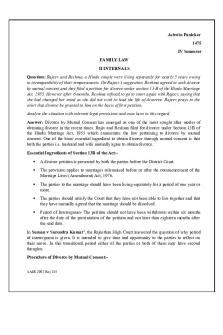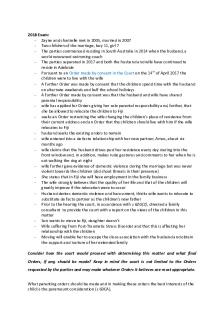Sports Law Practice Exams PDF

| Title | Sports Law Practice Exams |
|---|---|
| Course | Sports Law |
| Institution | Queensland University of Technology |
| Pages | 2 |
| File Size | 67.2 KB |
| File Type | |
| Total Downloads | 22 |
| Total Views | 187 |
Summary
Download Sports Law Practice Exams PDF
Description
Sports Law Practice Exams 2018 Exam Question 1 a) ISSUE Is Belinda owed a Duty of Care by the by anyone, and has this been breached? RULE Duty of care – City Netball, BCC Has duty been breached – Breached by BCC, not city netball. Damage has occurred because of it A person owes a duty of care to another if the person can reasonably be expected to have foreseen that if they did not take care, the other would suffer personal injury or death. ANALYSIS The council would owe a duty of care If the council owners of the court knew that there were gumnuts on the playing surface, and were likely aware of the gumnut trees nearby, it would be reasonably foreseeable that without taking/providing measures to remove them before matches, that someone may suffer injury. In Nowak, the Council, as the owner of the field Nowak injured themselves, owed a duty of care. Belinda having knowledge of the gumnuts prior to the injury does not prevent the duty from arising. City netball would also owe a due.
Does a duty of care exist? When a person is injured due to an act or omission by a party and the relationship does not fall into any established category of relationship, courts must ascertain whether a duty of care was owed by applying the following principles:
The harm must have been a reasonably foreseeable result of the defendant’s negligence; The harm suffered must be compensable and an infringement of a legally recognised right; Analogies must be able to be drawn with an established category of duty.
Was the duty of care breached? In establishing whether a duty of care was breached, courts consider the following questions:
Would a reasonable person in the defendant’s position have foreseen a significant risk of injury arising from their conduct? What would a reasonable person in the defendant’s position have done in response to that risk? Did the failure to do these things cause or contribute to the injury?
Conclusion
B) Issue: Has Belinda committed any violations pursuant to the World Anti doping code? If so, what sanctions may apply, and could she rely on any mitigations to reduce these sanctions. Netball Aus, the recognised national federation for the competition, has adopted WADA. Rule: Evading Sample collection, or without compelling justification, refusing or failing to submit to Sample collection after notification as authorized in applicable anti-doping rules. Analysis: Evading requires intent, which is proven on the facts by Rachel jumping out the window and leaving before the testing occurs. For violations of Article 2.3, the period of Ineligibility shall be four years unless, in the case of failing to submit to Sample collection, the Athlete can establish that the commission of the anti-doping rule violation was not intentional (as defined in Article 10.2.3), in which case the period of Ineligibility shall be two years.
Belinda would also be found to have violated article 2.1, taking a banned substance under the WADA ‘prohibited list’. Rule: It is each Athlete’s personal duty to ensure that no Prohibited Substance enters his or her body. Athletes are responsible for any Prohibited Substance or its Metabolites or Markers found to be present in their Samples. Analysis: It is not necessary that intent, Fault, negligence or knowing Use on the Athlete’s part be demonstrated in order to establish an anti-doping rule violation under Article 2.1. Would likely be ineligible for 2 years, as could prove under Section 10.2 that there was no intent to cheat. Conclusion
Question 2 Parties submit to the jurisdiction of the CAS through their agreement. Part of the agreement is that the decision of the CAS is final and binding and no appeal may be brought in a court....
Similar Free PDFs

Sports Law Practice Exams
- 2 Pages

Sports Law Notes
- 28 Pages

Taxation Law Deferred exams
- 7 Pages

Math304 Practice Exams
- 5 Pages

Microbiology 20 Practice Exams
- 5 Pages

Company LAW Exams Answers
- 6 Pages

Family Law Internal Exams
- 4 Pages

Practice exams - All Questions
- 133 Pages

Sports law week 8 lecture
- 3 Pages

LAW201 Sports LAW exam notes
- 24 Pages

Family Law past exams answers
- 22 Pages

BHP MCQs - Solved practice exams
- 22 Pages

Family Law II Internal Exams
- 3 Pages

Chapter 07-final - practice exams
- 12 Pages

Law Torts Note - past exams
- 102 Pages

RESA PW-AT - Practice Exams
- 24 Pages
Popular Institutions
- Tinajero National High School - Annex
- Politeknik Caltex Riau
- Yokohama City University
- SGT University
- University of Al-Qadisiyah
- Divine Word College of Vigan
- Techniek College Rotterdam
- Universidade de Santiago
- Universiti Teknologi MARA Cawangan Johor Kampus Pasir Gudang
- Poltekkes Kemenkes Yogyakarta
- Baguio City National High School
- Colegio san marcos
- preparatoria uno
- Centro de Bachillerato Tecnológico Industrial y de Servicios No. 107
- Dalian Maritime University
- Quang Trung Secondary School
- Colegio Tecnológico en Informática
- Corporación Regional de Educación Superior
- Grupo CEDVA
- Dar Al Uloom University
- Centro de Estudios Preuniversitarios de la Universidad Nacional de Ingeniería
- 上智大学
- Aakash International School, Nuna Majara
- San Felipe Neri Catholic School
- Kang Chiao International School - New Taipei City
- Misamis Occidental National High School
- Institución Educativa Escuela Normal Juan Ladrilleros
- Kolehiyo ng Pantukan
- Batanes State College
- Instituto Continental
- Sekolah Menengah Kejuruan Kesehatan Kaltara (Tarakan)
- Colegio de La Inmaculada Concepcion - Cebu